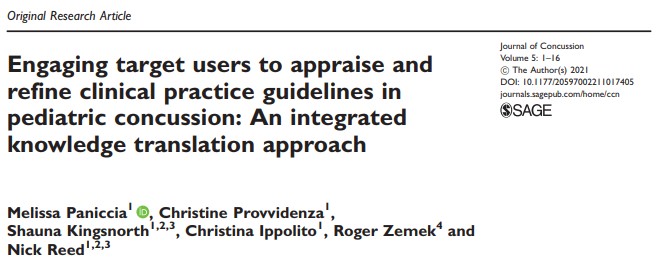Guideline in Practice
Sharing the Guideline Slide Deck
The slide decks below were created to facilitate the sharing and using of the Living Guideline for Diagnosing and Managing Pediatric Concussion (“Living Guideline”). They include information about the rationale, development process, and components of the Living Guideline.
1) Long version (21 slides)
2) Short version (12 slides)
Note: Slide decks are the property of the Ontario Neurotrauma Foundation and are for personal, non-commericial, and not-for-profit use only. For permission to modify the slide decks, please contact coordinator@onf.org.
‘Sharing and Using the Living Guideline for Diagnosing and Managing Pediatric Concussion’ Resource
As part of the October 2018 consensus meeting, expert panel members engaged in a knowledge translation activity that focused on how to best support healthcare professionals in the dissemination and implementation of the guideline. As an outcome of this process, the ‘Sharing and Using the Guideline for Diagnosing and Managing Pediatric Concussion’ resource was created to provide suggestions and practical tips.
Resource aims:
- Assist healthcare professionals to share the guideline. To help healthcare professionals share the guideline, a checklist is provided with ideas regarding:
- Who needs to know about guideline?
- What information is most important to share from the guideline?
- Why share the guideline?
- How should the information be shared?
- Foster use of the guideline in practice: Integrating recommendations from a guideline into practice takes time. It is important for healthcare professionals to know where their current concussion care practice aligns with the recommendations, and where gaps in practice may exist. Through this tool, healthcare professionals are encouraged to consider the following:
- Reflect on current practice.
- Identify recommendations that are practiced all of the time, some of the time or not at all.
- Prioritize recommendations that can be put into practice.
- Plan steps to take to put recommendations into practice.
This resource can be used as a tool to assist healthcare professionals while reviewing and prioritizing recommendations which they determine are key. These decisions are based on individual factors and their clinical context to facilitate the implementation of key recommendations into clinical practice. A series of essential questions are provided for healthcare professionals to consider as they plan to put recommendations into practice. Examples of essential questions include:
- How can the environment (e.g. clinic) support practice change?
- How can other stakeholders (e.g. leaders, colleagues) be engaged and involved?
- What might be some barriers to practice change?
- What strategies are needed to address barriers?
- Should anyone outside of your environment be involved?
- Did you or your team pilot test your plan?

